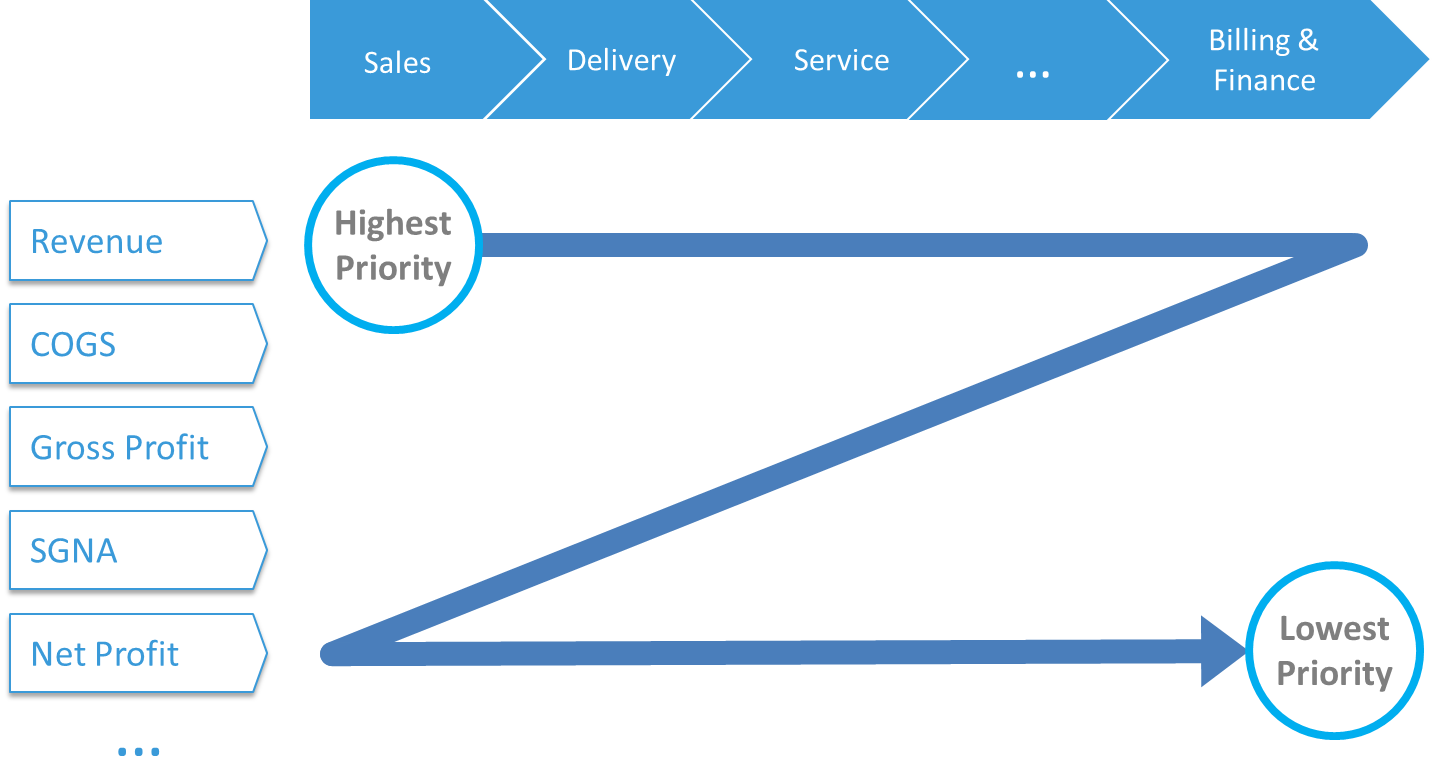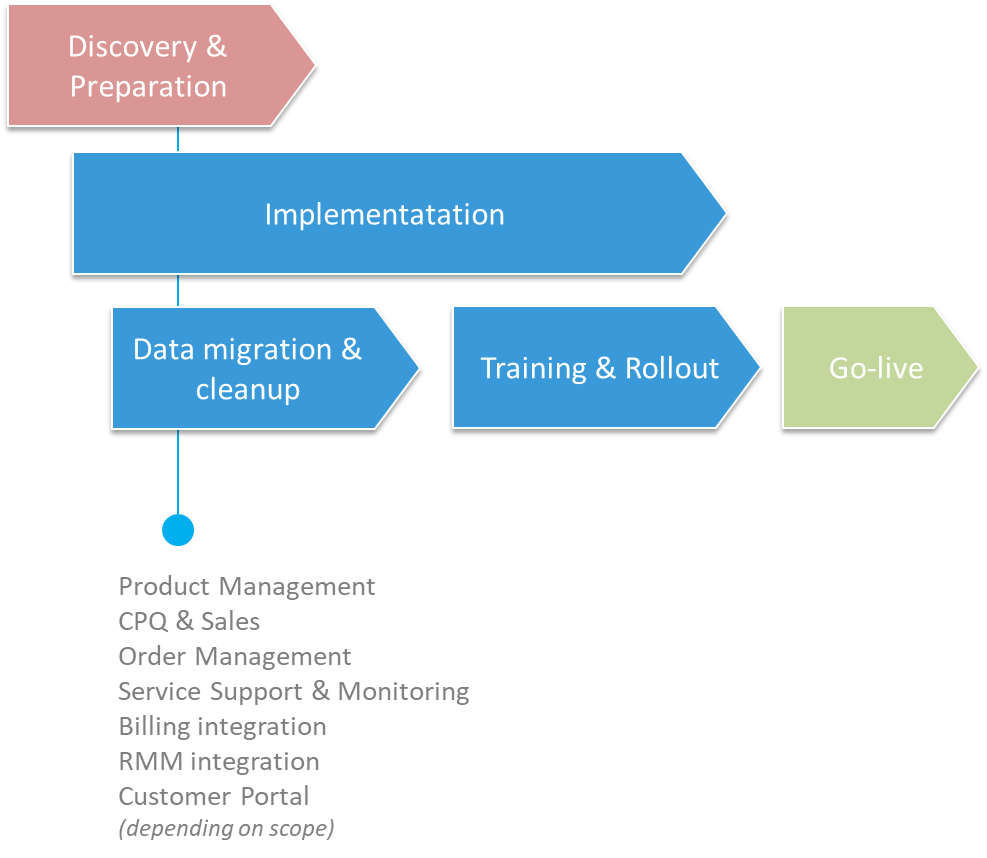Nextian Implementation Process Overview

Nextian is a Quote-to-Cash (QTC or Q2C) software platform for Cloud and Communications helping providers accelerate revenue growth and retain customer base.
The platform contains multiple modules such as CPQ, order management, service management, customer portal and others spanning the entire QTC spectrum.
Nextian modules can be purchased and deployed individually à la carte, depending on where they fit best. The idea is not to replace existing systems, but rather to supercharge them and fill the gaps.
Since various teams (Nextian, in-house IT, third-party integrators) can be responsible for implementations, establishing a consistent process is important.
This post outlines a high-level best-practice blueprint for Nextian implementations.
Determining scope
Nextian uses a proprietary Z-Model for Quote-to-Cash optimization to help customers prioritize their initiatives.
The model is a two-dimensional matrix based on Quote-to-Cash process flow and income statement:
The idea is that impact/importance usually follows Z-order like shown above.
See this post for more detail on the Z-Model establishing QTC optimization priorities.
Key phases
While the scope of work may vary, the overall sequence of project phases can be visualized as follows (with multiple Implementation phases for each module, e.g., CPQ, order management, etc.):
Discovery
Discovery sets the stage for the project. Its key objectives include:
- Determine gaps between current and desired state
- Establish success criteria
- Review KPIs
- Ensure stakeholder alignment
Discovery has two aspects to it:
- Business aspect: determine business problems to be solved, establish objectives and success criteria.
- Technical aspect: understand overall current technical landscape as well as the future state.
Preparation
Preparation involves setting up project management (project workbooks and other documentation, support portal access, etc.) as well as Salesforce (and other) sandbox environments.
Sandboxes allow making and testing changes before moving them to production.
Nextian recommends the following setup:
- Production Environment where the users work.
- Development Sandbox(es) where changes are implemented, reviewed, and initially tested.
- Full Sandbox(es) are copies of production environment used for final testing (development sandboxes usually have a limited subset of production data, full sandboxes enable testing under production-like conditions).
The environments are used as follows:
Implement (Development Sandbox) → Review (Development Sandbox) → Test (Full Sandbox) → Deploy (Production Environment)
Implementation
At Nextian, we believe in agile project management and delivery based on:
- Compartmentalizing work into very small, easily manageable steps
- Business reviews of small pieces of functionality
- Brief, daily calls with customers to review status and determine course of action for the next 1-2 days
The goal is to:
- Reduce inefficient email communication
- Enable customers to perform their daily jobs
- Eliminate risk of making wrong, “big” decisions by moving in smaller steps
- Demonstrate value as quickly as possible
Data migration and cleanup
It is likely that some data will have to be migrated into Salesforce from other systems during implementation. Depending on deployed Nextian modules, the data may include subscription information, product catalog, accounts, locations, contacts and others.
It is best to implement data migrations as incremental processes where:
- Many data import runs occur throughout the project
- Imports are typically starting with a limited set of objects and fields, and expanded with each run
Having duplicate or bad data is typically not critical when using Salesforce only as a CRM. This changes when other modules such as service management, support and others are introduced. For example, when services for a single account are created underneath two duplicates, account statistics (revenue, purchased products, support cases) will be incorrect.
Therefore, data consolidation and cleanup are paramount to obtain the accurate picture of the business.
See this post for more information on data cleanup strategies.
| Important | Efforts related to data migration are often underestimated and can quickly bubble up to a project of its own. |
Security configuration
When using Salesforce only for CRM, out-of-the box configuration is usually sufficient along with minimum changes to the user roles and their hierarchy.
For orders, service management, advanced account analytics, etc., additional security modifications are required (departmental apps, profiles, permission set groups, etc.) to protect sensitive data.
See this post for more information on Nextian approach to Salesforce security.
Rollout
Nextian recommends soft launch / full go-live approach to rollouts. A soft launch is a go-live with limited scope (a single customer, limited team or only one product).
The goal is to validate that the system works as intended, minimizing risks at the same time. The full go-live follows once all the issues discovered during the soft-launch have been resolved.
Both soft launch and the full go-live usually require a lot of end-user assistance from the implementation team.
End-user training
End-user training in transformation projects is a challenge. Regardless of budgets allocated and time spent in training rooms, when systems go live, the results are often unsatisfactory.
At Nextian we recommend shifting budget towards post-go-live user-support rather than pre-go-live training. Having support personnel help the users to solve the problems on the job is by far the most effective method of training.
Additional user shadowing can also be employed to find most common problems, process bottlenecks and collect user feedback.
See this post for more information on Nextian approach to training in transformation projects.
Conclusions
Nextian implementation process is lightweight, effective and has been successfully verified with customers.
It is based on agile approach to project management, transparency and customer engagement.
The process has been designed to:
- Achieve business goals
- Prove value and realize ROI quickly
- Enable innovation
- Ensure cost effectiveness
It begins with a formal method of establishing and prioritizing initiatives, followed by iterative implementation of individual modules and finishes with user training and go-live. Data security, migration and cleanup are integral parts of the process.
Nextian is a vendor of Quote-to-Cash (QTC) software for cloud and communications helping providers accelerate growth and increase customer lifetime value.
Contact us today to find out how we can help you!








